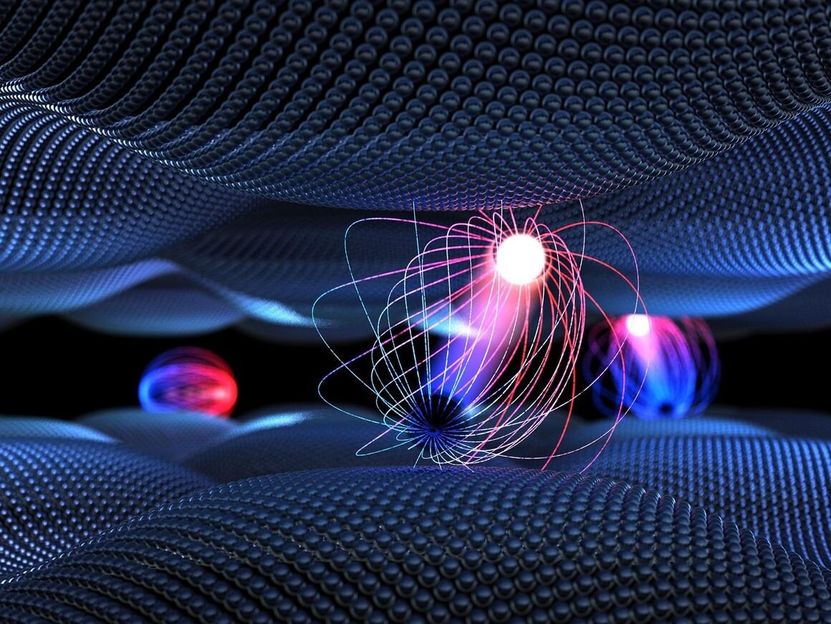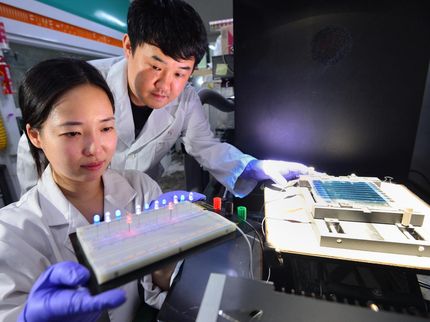Building blocks of the future for photovoltaics
Research team observes formation of "dark" moiré interlayer excitons for the first time
An international research team led by the University of Göttingen has, for the first time, observed the build-up of a physical phenomenon that plays a role in the conversion of sunlight into electrical energy in 2D materials. The scientists succeeded in making quasiparticles – known as dark Moiré interlayer excitons – visible and explaining their formation using quantum mechanics. The researchers show how an experimental technique newly developed in Göttingen, femtosecond photoemission momentum microscopy, provides profound insights at a microscopic level, which will be relevant to the development of future technology. The results were published in Nature.

Artistic representation showing the twisted layers of tungsten diselenide (top) and molybdenum disulphide (bottom). Following excitation using light, a multitude of optically “dark” excitons form between the layers. These “dark” excitons are electron-hole pairs bound by Coulomb interaction (light and dark spheres connected by field lines), which cannot be directly observed using visible light. One of the most interesting quasiparticles is the "moiré interlayer exciton" – shown in the middle of the image - in which the hole is located in one layer and the electron in the other. The formation of these excitons on the femtosecond time scale and the influence of the Moiré potential (illustrated by peaks and troughs in the layers) were investigated in the current study using femtosecond photoemission momentum microscopy and quantum mechanical theory.
Brad Baxley, Part to Whole, LLC
Atomically thin structures made of two-dimensional semiconductor materials are promising candidates for future components in electronics, optoelectronics and photovoltaics. Interestingly, the properties of these semiconductors can be controlled in an unusual way: like Lego bricks, the atomically thin layers can be stacked on top of each other. However, there is another important trick: while Lego bricks can only be stacked on top – whether directly or twisted at an angle of 90 degrees – the angle of rotation in the structure of the semiconductors can be varied. It is precisely this angle of rotation that is interesting for the production of new types of solar cells. However, although changing this angle can reveal breakthroughs for new technologies, it also leads to experimental challenges. In fact, typical experimental approaches have only indirect access to the moiré interlayer excitons, therefore, these excitons are commonly termed “dark” excitons. "With the help of femtosecond photoemission momentum microscopy, we actually managed to make these dark excitons visible," explains Dr. Marcel Reutzel, junior research group leader at the Faculty of Physics at Göttingen University. "This allows us to measure how the excitons are formed at a time scale of a millionth of a millionth of a millisecond. We can describe the dynamics of the formation of these excitons using quantum mechanical theory developed by Professor Ermin Malic’s research group at Marburg."
"These results not only give us a fundamental insight into the formation of dark Moiré interlayer excitons, but also open up a completely new perspective to enable scientists to study the optoelectronic properties of new and fascinating materials," says Professor Stefan Mathias, head of the study at Göttingen University's Faculty of Physics. "This experiment is ground-breaking because, for the first time, we have detected the signature of the Moiré potential imprinted on the exciton, that is, the impact of the combined properties of the two twisted semiconductor layers. In the future, we will study this specific effect further to learn more about the properties of the resulting materials."
Original publication
Most read news
Original publication
Topics
Organizations
Other news from the department science

Get the chemical industry in your inbox
By submitting this form you agree that LUMITOS AG will send you the newsletter(s) selected above by email. Your data will not be passed on to third parties. Your data will be stored and processed in accordance with our data protection regulations. LUMITOS may contact you by email for the purpose of advertising or market and opinion surveys. You can revoke your consent at any time without giving reasons to LUMITOS AG, Ernst-Augustin-Str. 2, 12489 Berlin, Germany or by e-mail at revoke@lumitos.com with effect for the future. In addition, each email contains a link to unsubscribe from the corresponding newsletter.




























































